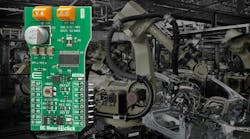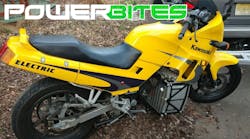Low-Cost Real-Time MCUs Handle Advanced Motor-Control Functions
What you'll learn:
- How the new MCUs save costs.
- Implementation of TI's InstaSPIN FOC software and advanced algorithms.
- Range of applications for these MCUs.
Texas Instruments’ F28E120SC and F28E120SB microcontrollers (MCUs) help engineers design products with industry-leading performance at a lower cost. They offer 30% faster computing power than previous generations, which can be used for single-motor and power-factor-correction (PFC) systems.
By integrating TI’s C28x digital-signal-processor core, a high-speed digital-to-analog converter (DAC), and a programmable gain amplifier, they eliminate the cost and PCB footprint of additional components for simpler, lower-cost, higher-performing designs. Applications include home appliances such as washing machines and dishwashers, vacuum cleaners, and power tools.
The new MCUs support TI’s proprietary InstaSPIN field-oriented-control (FOC) software and advanced algorithms, which enable smoother, quieter, and more efficient motor performance. Their advanced capabilities — including high-speed sensorless FOC, high-torque zero-speed startup, and sophisticated vibration compensation — deliver high-precision, responsive motor control for many consumer applications.
For example, their vibration compensation algorithm can achieve up to 60% speed ripple reduction. It counteracts the acoustic noise and vibrations caused by an imbalanced load in applications such as washing machines.
Preproduction quantities of the F28E12x MCUs are available now on TI.com, with package and memory variants starting at US$0.49 in 1,000-unit quantities. In addition, the company provides an ecosystem of resources that help engineers easily and quickly design motor-control systems:
- An evaluation module available for US$19.00.
- Motor- and power-control reference designs.
- A full motor-control software development kit featuring code examples, application-specific algorithms, and a graphical device configuration tool.
For more information, read the technical article, “Achieving smoother, quieter motor performance with highly integrated real-time control MCUs.”
Next in This Edition of PowerBites
More PowerBites
About the Author
Lee Goldberg
Contributing Editor
Lee Goldberg is a self-identified “Recovering Engineer,” Maker/Hacker, Green-Tech Maven, Aviator, Gadfly, and Geek Dad. He spent the first 18 years of his career helping design microprocessors, embedded systems, renewable energy applications, and the occasional interplanetary spacecraft. After trading his ‘scope and soldering iron for a keyboard and a second career as a tech journalist, he’s spent the next two decades at several print and online engineering publications.
Lee’s current focus is power electronics, especially the technologies involved with energy efficiency, energy management, and renewable energy. This dovetails with his coverage of sustainable technologies and various environmental and social issues within the engineering community that he began in 1996. Lee also covers 3D printers, open-source hardware, and other Maker/Hacker technologies.
Lee holds a BSEE in Electrical Engineering from Thomas Edison College, and participated in a colloquium on technology, society, and the environment at Goddard College’s Institute for Social Ecology. His book, “Green Electronics/Green Bottom Line - A Commonsense Guide To Environmentally Responsible Engineering and Management,” was published by Newnes Press.
Lee, his wife Catherine, and his daughter Anwyn currently reside in the outskirts of Princeton N.J., where they masquerade as a typical suburban family.
Lee also writes the regular PowerBites series.





